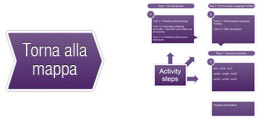

Evaluating listening skills
di E. Darling, British Council
Task 2.2. A2/B1 descriptors
(15 minutes)
 Below are the CEF and DIALANG self assessment statements for listening at A2 and B1 level.
Below are the CEF and DIALANG self assessment statements for listening at A2 and B1 level.
Look at the descriptors. What are the main differences between A2 and B1 listening ability?
A2
- I can understand phrases and expressions related to immediate needs.
- I can generally identify the topic of discussion around me which is conducted slowly and clearly.
- I can generally understand clear, standard speech on familiar matters, although in a real life situation. I might have to ask for repetition or reformulation.
- I can handle simple business in shops, post-offices or banks.
- I can understand enough to be able to meet concrete needs in everyday life provided speech is clear and slow.
- I can understand enough to manage simple, routine exchanges without too much effort.
- I can understand simple directions relating to how to get from X to Y, by foot or public transport.
- I can catch the main point in short, clear, simple messages and announcements.
- I can understand the essential information from short recorded passages dealing with predictable everyday matters which are spoken slowly and clearly.
- I can identify the main point of TV news items reporting events, accidents, etc., where the visual material supports the commentary.
B1
- I can guess the meaning of occasional unknown words from the context and understand sentence meaning if the topic discussed is familiar.
- I can generally follow the main points of extended discussion around me, provided speech is clear and in standard language.
- I can follow clear speech in everyday conversation, though in a real life situation I will sometimes have to ask for repetition of particular words and phrases.
- I can understand straightforward factual information about common everyday or job-related topics, identifying both general messages and specific details, provided speech is clear and generally familiar accent is used.
- I can understand the main points of clear standard speech on familiar matters which occur regularly.
- I can understand simple technical information, such as operation instructions for everyday equipment.
- I can understand the information content of the majority of recorded or broadcast audio material about familiar subjects spoken relatively slowly and clearly.
- I can catch the main points in broadcasts on familiar topics and topics of personal interest when the language is relatively slow and clear.
- I can listen to a short narrative and form hypotheses about what will happen next.
- I can follow a lecture or a talk within my own field, provided the subject matter is familiar and the presentation straightforward and clearly organised.
- I can follow many films in which visuals and action carry much of the storyline, and in which the story is straightforward and the language clear.
